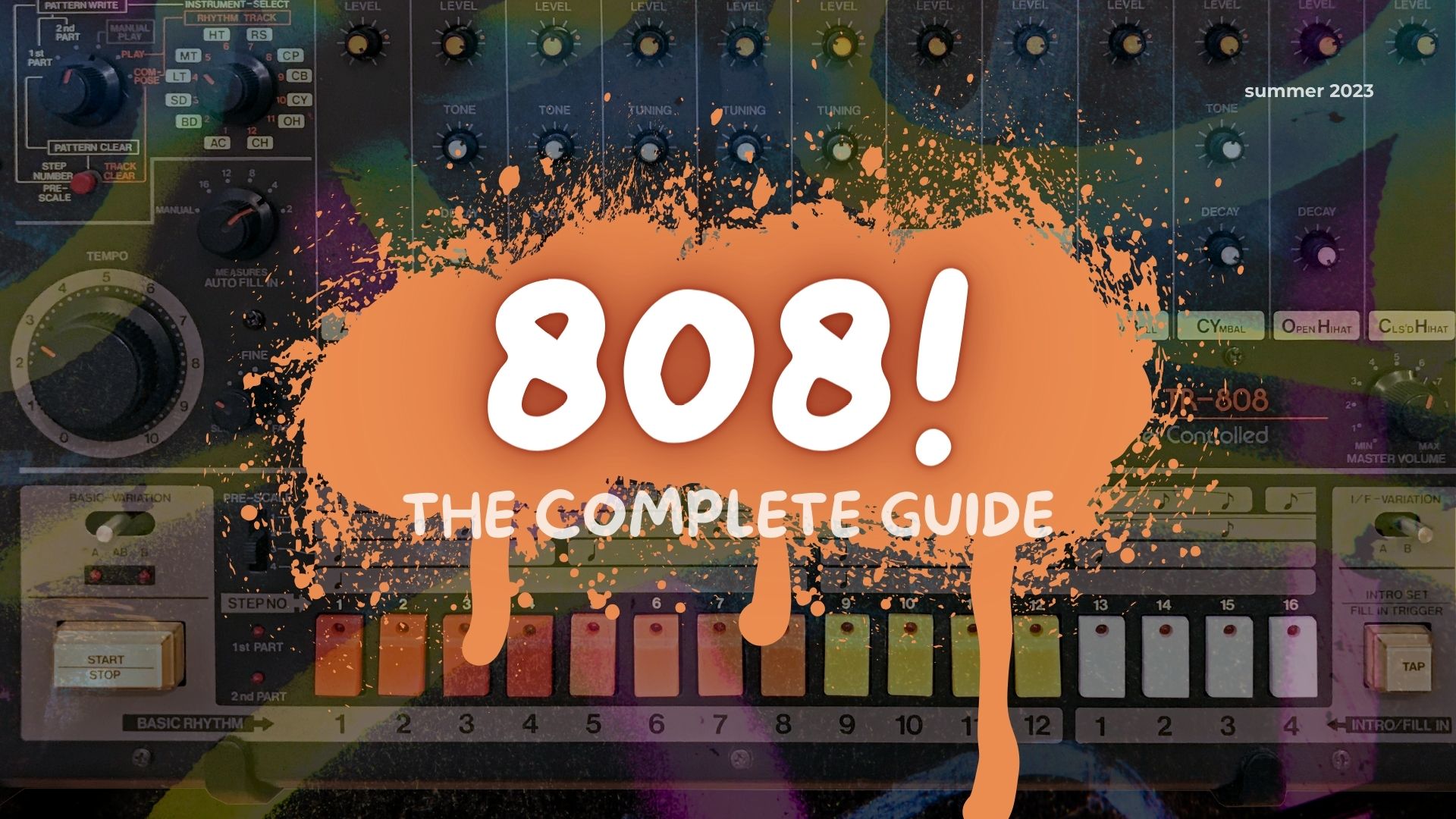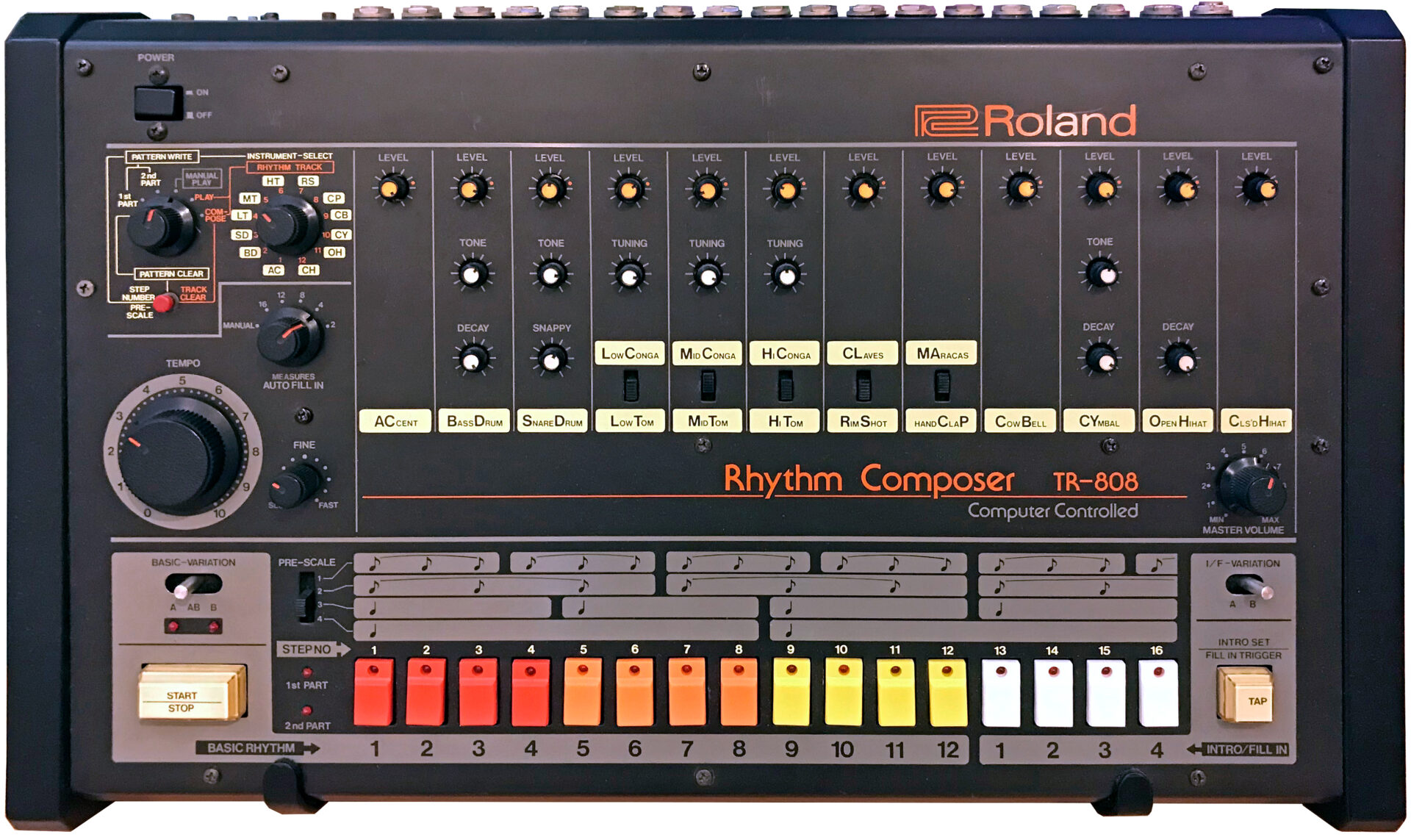What an 808 Really Is: A Guide to Making and Mixing 808 Sounds
Today, we’re diving deep into the heart of one of the most important sounds in music production by exploring the history and use of the iconic 808 bass sound.
I’ve been producing music for over 15 years, and making sample packs for 10 years, immersing myself in the vibrant world of hip hop and EDM from the very beginning of my journey.
From the moment I was introduced to these insane basses as a kid, I’ve been captivated by their allure, their depth, and their undeniable impact on the sound of modern music.
I’ve gone on to create hundreds of these types of sounds for my free sample libraries, and now I want to teach you how to do the same.
But first, we’ve got to set the record straight about what an 808 even is. Is it a kick? Is it bass? Is it both?
Unearthing the Roots: The History of 808s
The story of the 808 begins in the early 1980s when the Roland Corporation released their iconic TR-808 Rhythm Composer.
Created by Ikutaro Kakehashi and his team, this drum machine was revolutionary at the time, featuring deep, booming bass sounds that would go on to define entire genres.
While it was initially created for accompanying musicians during live performances, the 808 found its true calling in the studio in the emerging hip hop scene of the time.
As hip hop evolved, so did the use of the 808. From its humble beginnings in the streets of New York City, it spread like wildfire, taking over mainstream music and transcending genre boundaries. Its distinctive sound became synonymous with not just hip hop, but also electronic, pop, and even rock music, leaving an undeniable mark on music production forever.
The original TR-808 units featured all sorts of percussion sounds: snares, hi hats, cymbals… But most notably, they produced synthesized bass drum and tom sounds that producers treated, warped, manipulated and re-tuned to serve not only as kicks, but eventually as the foundation of bass lines for their tracks.
This original 808 sound was produced by simply generating a low sine wave and adjusting its attack and release profile to create the kind of low, throbbing tone that has been used as the basis for bass and kick sounds on countless hip hop, electronic and pop records since.
But language evolves. The “808” sounds we hear in modern production are rarely stock sounds pulled from an original TR-808 drum machine.
When producers throw around the term “808” today, they are usually referring to any kind of low bass sound that resembles the iconic synthesized kick and tom sounds from the original 808s——especially deep bass lines that roughly follow the kick pattern. Some 808 sounds will even play the role of kick and bass in the track at the same time.
Producers of today are more likely to synthesize 808-inspired tones for themselves—or take advantage of custom sample libraries full of distinctive new takes on the classic 808 sound.
However you get them, treating an 808 to sound memorable and fresh is an art form of its own, which we’ll explore in more detail as we go along.
How To Make The Perfect 808 Sound from Scratch With VST Plugins
Now, let’s get hands-on and dive into the process of creating 808s that shake speakers. Although I’m a big believer in the advantages of well-curated sample libraries, the truth is that you can also synthesize 808s for yourself pretty easily.
Below, we’ll look at how to use three popular VST plugins to create your own 808 sounds from scratch: Xfer Serum, Ableton Operator, and Future Audio Workshop Sublab XL. The process is similar with each of them.
Xfer Serum: Start by initializing a new instance of Serum. Select a sine or square wave oscillator and lower its octave by 2 to achieve a deeper tone.
A sine wave will sound closer to the original 808 sound, while a square wave will give you additional harmonics to start with for a more complex tone.
Adjust the envelope to shape the amplitude of the sound, by giving it a quick and punchy attack with a longer sustained tail.
The example below shows an approach where adjusting LFO settings can change the shape of the sound pretty radically.
From here, you can add subtle distortion or saturation to add warmth, character and upper harmonics. Then, sculpt the sound further with Serum’s onboard EQ. While it’s tempting to just boost bass, recognize that what gets your 808s heard on smaller systems is their midrange.

Ableton Operator: The process with Abelton’s Operator is pretty similar. Open Operator and select the default sine or square wave oscillator and pitch it down 2 octaves. Adjust the envelope to shape the volume envelope, emphasizing the attack and adjusting the decay and sustain to the desired length.
Layer multiple oscillators if necessary to add richness and depth to the sound. Try using FM (frequency modulation) or Operator’s waveform editor to add additional “partials” or harmonics to the 808 for a more complex sound. Then, experiment with Operator’s built-in effects like saturation and filtering to tailor the sound to your liking.

Future Audio Workshop Sublab XL: Fire up Sublab XL and initialize a new patch. This instrument is designed for synthesizing subs, so you can explore a pretty diverse library of preset 808 sounds right out of the gate, or start from scratch by simply selecting a sine or square wave oscillator.
As with any of the synths we’ve looked at, you’ll want to fine-tune the attack and decay parameters to sculpt the basic sound, and then add harmonics and character with Sublab’s distortion and saturation modules.
Try using the “X-Sub” feature, which adds more sub and/or harmonics to the 808. Utilize the built-in compressor and transient shaper to tighten up the sound and ensure it cuts through the mix.

The Best Plugins for 808 Processing and Mixing
Now that we’ve sculpted the perfect 808 to start off with, it’s time to elevate it to the next level with some top-notch plugins.
Since a raw 808 sample is so sonically simple, adding harmonics is the key to making them sound much more interesting and unique. Here are my top five recommendations for that:
Waves R-Bass: This psychoacoustic tool adds upper harmonics to your 808s that reinforce the sound of the low end, adding perceived weight and definition in the bottom without sacrificing clarity—and without getting lost on smaller systems.
Soundtoys Decapitator: Inject tons of character and grit into your 808s with this analog saturation plugin, emulating the warm, harmonically-rich distortion of vintage hardware and bringing some much needed personality to the original signal.
Native Instruments Guitar Rig: Guitar Rig is an excellent tool for processing 808s due to its wide array of effects and incredibly intuitive interface. While it’s primarily designed for guitar processing, its extensive collection of effects, including broad shaping EQs, character compressors, distortion and overdrive, it can be used to radically sculpt and reshape the character of 808s.
PSP VintageWarmer2: Infuse your 808s with warmth and vintage vibe using this classic analog-style compressor and saturator. This one is perfect for adding depth, warmth and character to your tracks.
FabFilter Saturn 2: This unusually versatile distortion plugin offers unparalleled control over your sound, allowing you to add harmonics and reshape the overall tone of your 808 at the same time.
Top 10 Best 808 Sample Packs Online (Free & Paid)
For those looking to expand their 808 sample library, here are my top picks for 808 sample packs available online—both free and paid.
My own free libraries from Adieu Sounds are easily my favorites on this list, but there are so many places to find great 808 samples today. Here are my top 10:
Adieu Sounds – Monster 808s: This free pack includes 300+ 808 samples that are great for any genre. It comes with everything from clean subs to extremely distorted basses.
Adieu Sounds – Trap Essentials: This free multi-kit is one of my favorites I’ve created, and includes 808 samples plus everything else you need to make trap music.
Tri Samples – 808 Trapstep Vol 1: This pack comes with great 808 samples, plus other types of hip hop drum one shots.
Producer Grind – Boomin 808 Collection: This kit contains some of legendary producer Metro Boomin’s go to 808 samples.
Samples From Mars – 808s From Mars: This collection of 808s was created using a real TR-808 machine. It includes both clean and processed 808 samples
Capsun ProAudio – Sub Drip 808s: This pack includes 808s, sub basses, and Serum presets.
Abletunes – Free 808 Samples: This kit comes with 50 808 samples created with analog drum machines and drum synths.
Drumkito – Roland TR-808 Sample Pack: Another 808 pack created using the TR-808 drum machine. It also comes with snares, hihats, and more from this iconic instrument.
Surge Sounds – Free 808 Basses: A collection of 100 808 samples inspired by Travis Scott, Post Malone, and other influential artists.
Circuit Tracks – 808 Drum Pack: 64 808 one shot samples including clean, dusty cassette, hot tubes, and old tape processed bass drums.
Conclusion
With these resources at your disposal, you’ll have everything you need to create and process earth-shattering 808s that demand attention and elevate your productions to new heights. It’s time to unleash the power of the 808! Until next time, keep producing and crafting those sonic masterpieces.
Drew Adieu is a music producer and founder of AdieuSounds.com
This post was made in collaboration with Adieu Sounds. Big thanks to them for supporting the site, and for providing free sample libraries to our readers.
Please note: When you buy products through links on this page, we may earn an affiliate commission.








